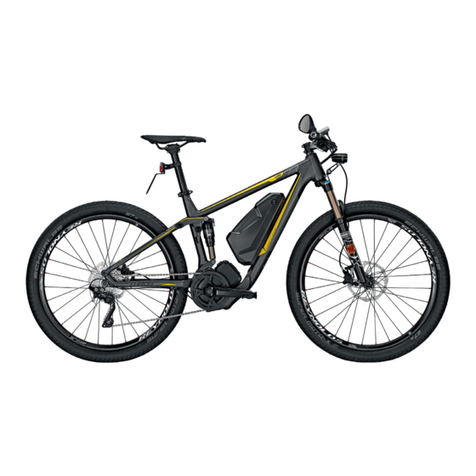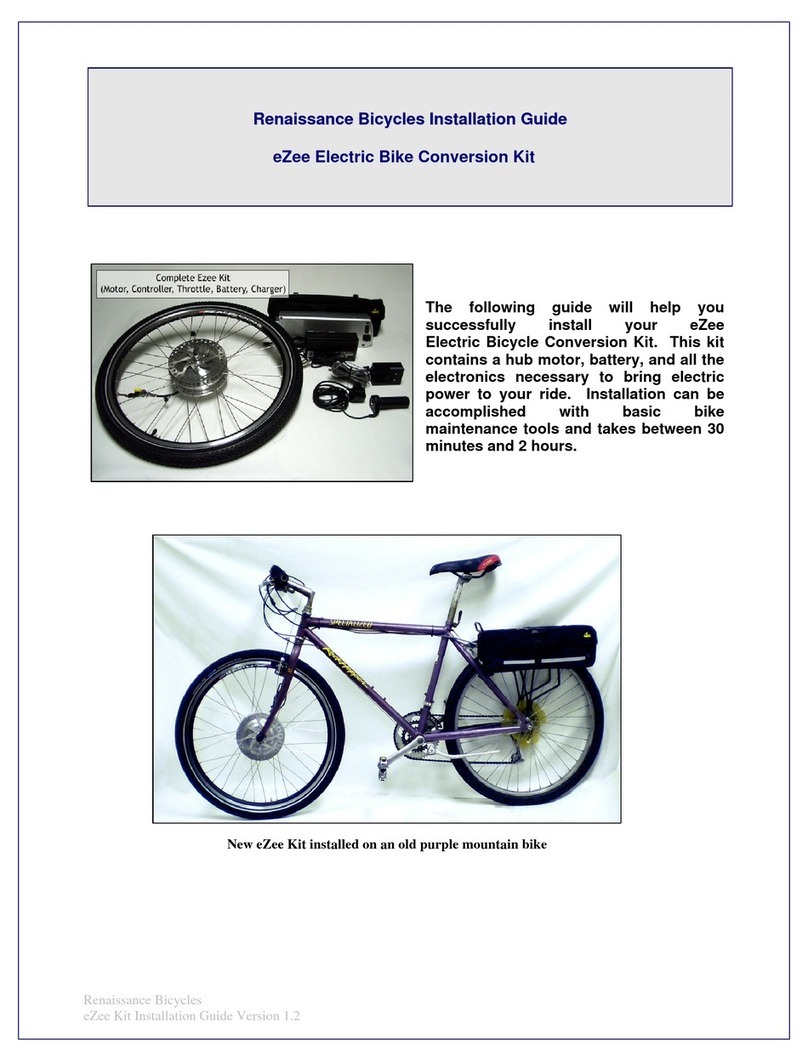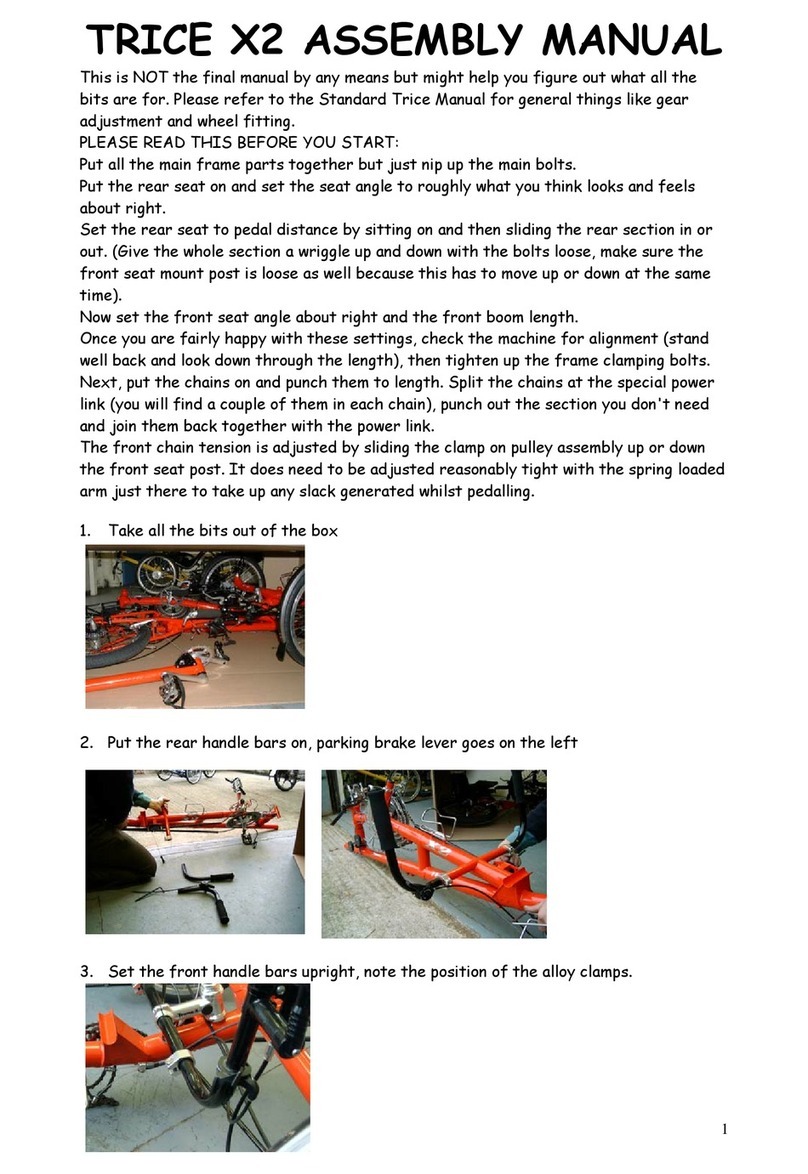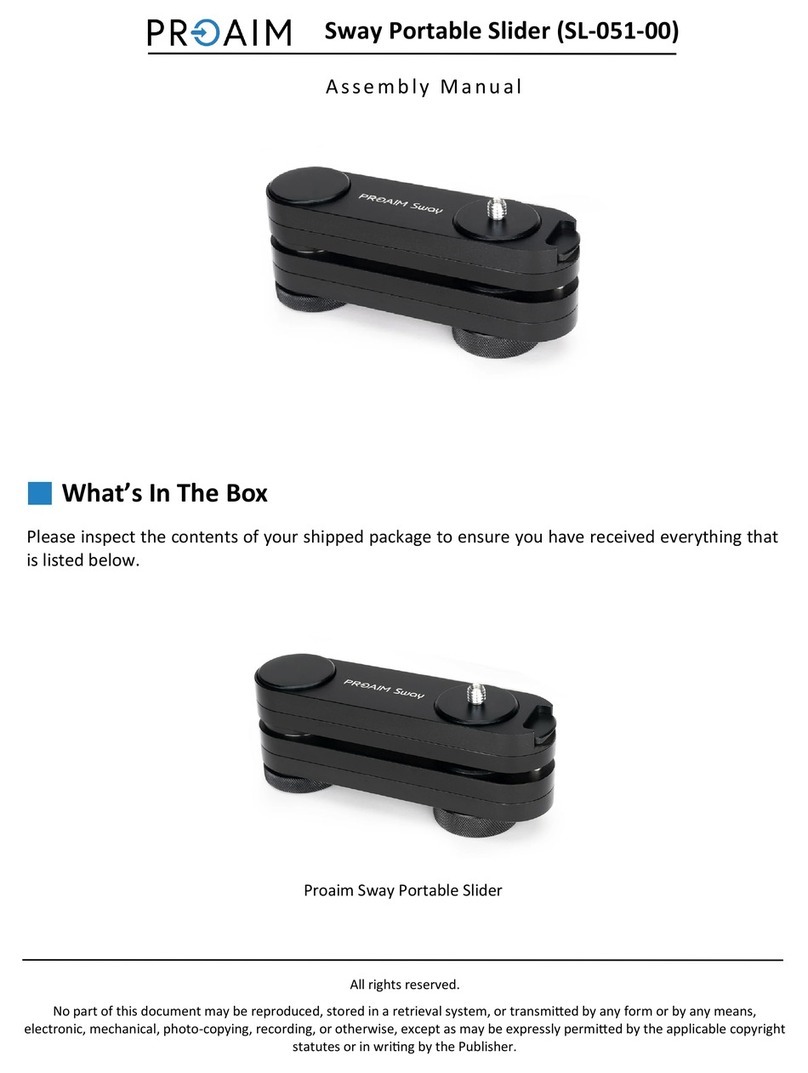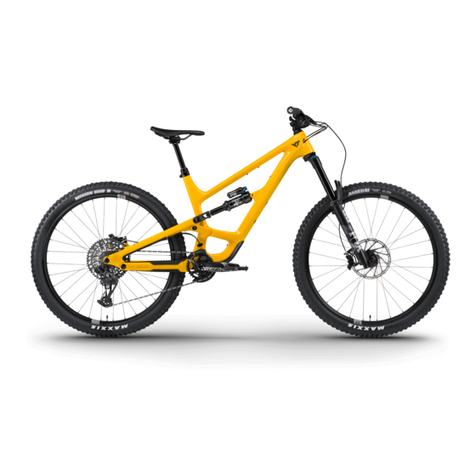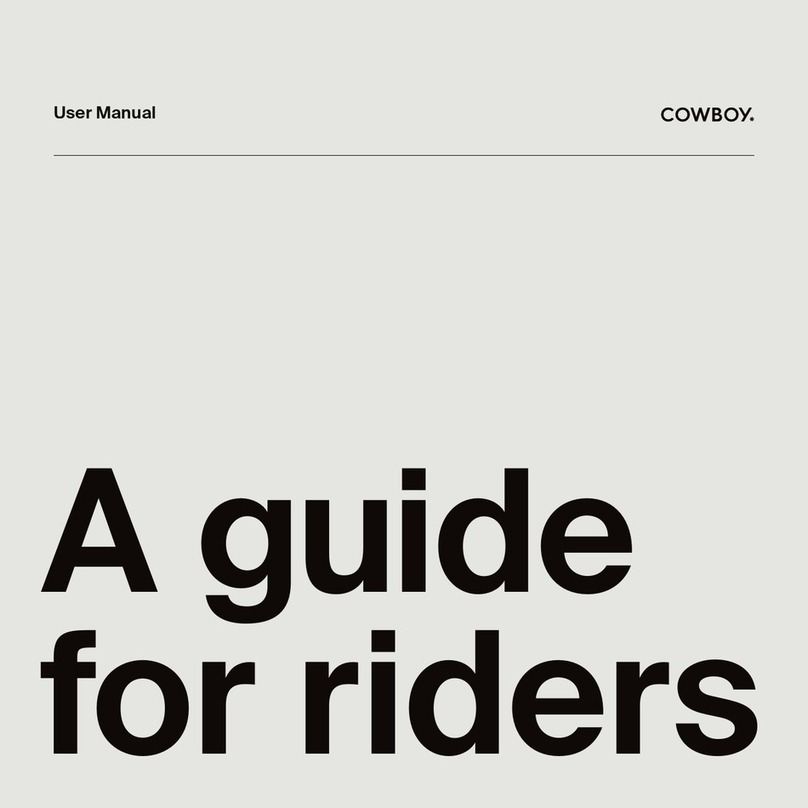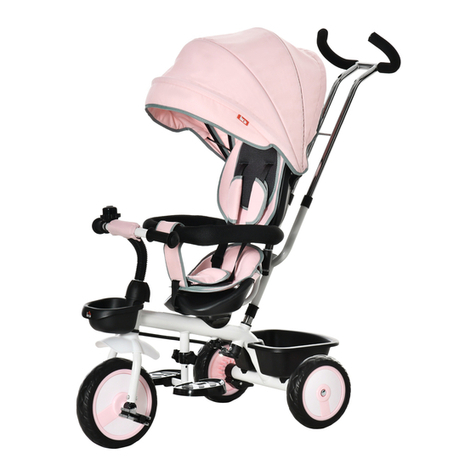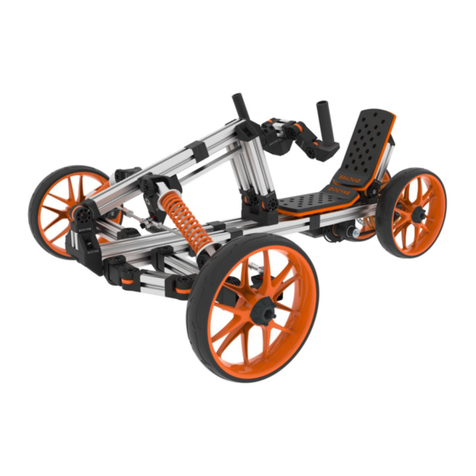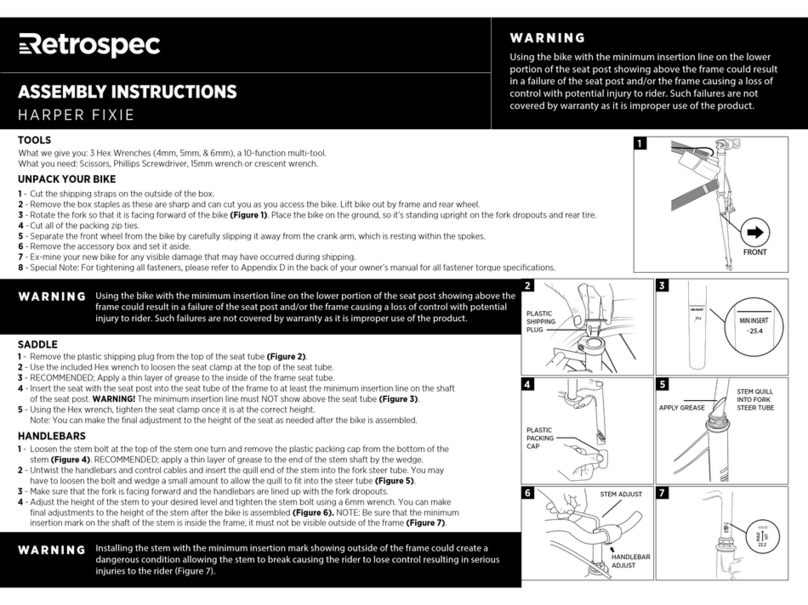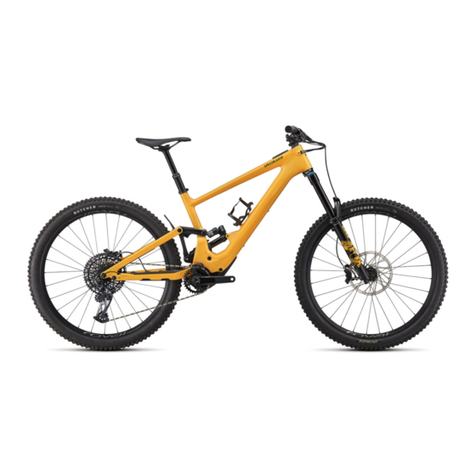ProActiv NJ1 Parts list manual

Usage instructions for NJ1 & FREAK compact bike
0
Usage instructions
Service booklet
NJ1 compact bike
FREAK Compact bike

Usage instructions for NJ1 & FREAK compact bike
1
Contents
1 Preface ............................................................................................................................................... 4
2 Legend ................................................................................................................................................ 4
3 Conformity/other information .............................................................................................................. 4
3.1 Classification ............................................................................................................................... 4
3.2 Conformity................................................................................................................................... 4
3.3 Manufacturer ............................................................................................................................... 4
4 Scope of delivery and testing the product on receipt ......................................................................... 4
5 Introduction ......................................................................................................................................... 5
6 Purpose and indication ....................................................................................................................... 5
7 Proper use .......................................................................................................................................... 6
8 Technical specifications ..................................................................................................................... 6
8.1 Product weight ............................................................................................................................ 6
8.2 Load weight................................................................................................................................. 7
8.3 Ground clearance & turning circle .............................................................................................. 7
8.4 Basic equipment and dimensions ............................................................................................... 7
8.5 Service life .................................................................................................................................. 7
9 Rating plate and markings on the product ......................................................................................... 7
10 Commissioning and handover ............................................................................................................ 8
11 Introduction to the product and the surroundings ............................................................................... 8
12 Safety instructions – prior to driving/use ............................................................................................ 8
13 Safety instructions – while driving/using ............................................................................................ 9
14 Safety instructions regarding obstacles ........................................................................................... 10
15 Safety instructions regarding dangerous locations and dangerous situations ................................. 10
16 Functional elements ......................................................................................................................... 11
16.1 Bottom bracket support and crank ................................................................................... 11
16.1.1 Seating position ........................................................................................................... 11
16.1.2 Bottom bracket position ............................................................................................... 12
16.1.3 Crank length and grip width ......................................................................................... 13
16.2 Grips ......................................................................................................................................... 14
16.3 Gear shift .................................................................................................................................. 14
16.3.1 Derailleur ...................................................................................................................... 14
16.3.2 Hub gear ...................................................................................................................... 15
16.3.3 Charging the battery for Shimano electronic gearshifts ............................................... 16
16.3.4 Bottom bracket gearshift .............................................................................................. 17
16.4 Brakes ....................................................................................................................................... 18
16.4.1 Rim and disc brakes .................................................................................................... 18

Usage instructions for NJ1 & FREAK compact bike
2
16.4.2 Back-pedal brake for hub drives .................................................................................. 19
16.4.3 Parking brake ............................................................................................................... 19
16.5 Lights ........................................................................................................................................ 19
16.6 Bell ............................................................................................................................................ 19
16.7 Manufacturer instructions ......................................................................................................... 20
17 Backrest ............................................................................................................................................ 20
17.1 Angle adjustment of the backrest ............................................................................................. 20
17.2 Longitudinal positioning of the backrest ........................................................................... 21
18 Seat system ...................................................................................................................................... 21
19 Neck rest .......................................................................................................................................... 22
19.1 Neck rest height adjustment ............................................................................................. 22
19.2 Neck rest angle adjustment ...................................................................................................... 22
20 Collision guard .................................................................................................................................. 23
20.1 Collision guard mount ............................................................................................................... 23
20.2 Mounting the collision guard ..................................................................................................... 23
20.3 Adjusting the length of the collision guard ....................................................................... 24
21 Wheels .............................................................................................................................................. 24
21.1 Removing and attaching the running wheels ............................................................................ 24
21.2 Checking and setting the wheel tracking ......................................................................... 24
21.3 Tyre pressure ............................................................................................................................ 26
22 Adaptation and decoupling the drive unit ......................................................................................... 27
22.1 Safety instructions .................................................................................................................... 27
22.2 Terminology .............................................................................................................................. 27
22.3 Adapting the drive unit .............................................................................................................. 27
22.4 Decoupling the drive unit .......................................................................................................... 29
23 Storage ............................................................................................................................................. 30
24 Transport .......................................................................................................................................... 30
24.1 Securing handling of the product .............................................................................................. 30
24.2 Passenger transport in vehicles ............................................................................................... 30
24.3 Securing the product in a vehicle (without a person) ............................................................... 30
25 Malfunctions ..................................................................................................................................... 31
26 Cleaning and care ............................................................................................................................ 31
27 Maintenance ..................................................................................................................................... 32
27.1 General instructions .................................................................................................................. 32
27.2 Service schedules ..................................................................................................................... 32
27.3 Proof of maintenance ................................................................................................................ 33

Usage instructions for NJ1 & FREAK compact bike
3
28 Disposal and recycling ..................................................................................................................... 33
29 Re-use .............................................................................................................................................. 33
30 Warranty ........................................................................................................................................... 34
31 Liability .............................................................................................................................................. 34
32 Appendix: Tightening torques, securing details and tools ................................................................ 35
33 Appendix: Medical product passport/record of training .................................................................... 36
34 Appendix: Hand-over certificate ....................................................................................................... 37
34.1 Required compliance criteria to authorise use ......................................................................... 37
34.2 Check list for training the user .................................................................................................. 38
35 Appendix: Inspection lists ................................................................................................................. 39
The following instructions are intended for and may only be carried out by the rehabilita-
tion specialist dealer or PRO ACTIV.
This document is available in PDF format at www.proactiv-gmbh.com for visually impaired
people. Using the zoom function, the font can be increased as desired.

Usage instructions for NJ1 & FREAK compact bike
4
1 Preface
Dear Customer,
Congratulations on purchasing your new
PRO ACTIV product. You have bought a quali-
ty product that has been specially customised
to meet your requirements. We have put to-
gether some instructions about its proper and
safe use in the following document. Please
read these instructions before using the prod-
uct.
The standard components are explained in
these usage instructions. If you have individual
solutions or non-standard components on your
product, your rehabilitation specialist dealer or
PRO ACTIV would be happy to deal with any
questions you may have about using it.
The only difference between the NJ1 & FREAK
compact bikes is the design of the frame (or in
the frame sizes that can be selected). The
operating instructions are therefore identical.
You can always download the latest version of
the usage instructions as a PDF document in
our download area at www.proactiv-gmbh.com.
If you have any further questions about this or
any of our other products, we would be glad to
be at your disposal.
Enjoy your trips and the best possible mobility.
Your PRO ACTIV team
2 Legend
The symbols used in these usage instructions
have the following meanings:
Manufacturer
Warnings and safety instructions
Serial number
3 Conformity/other information
3.1 Classification
NJ1 & FREAK compact bikes (referred to as
the "product" below) are classified as class I
products.
3.2 Conformity
As the manufacturer, PRO ACTIV
Reha-Technik GmbH declares that
the respective product is a class I product and
meets the requirements of the EU Medical
Devices Directive (2017/745).
If the product is adapted in a manner which
has not been agreed by PRO ACTIV Reha-
Technik GmbH, this declaration becomes void.
3.3 Manufacturer
PRO ACTIV Reha-Technik GmbH
Im Hofstätt 11
D-72359 Dotternhausen
Phone +49 7427 9480-0
Fax +49 7427 9480-7025
e-mail: info@proactiv-gmbh.de
web: www.proactiv-gmbh.com
4 Scope of delivery and testing
the product on receipt
Delivery includes the product, configured as
per the purchase order, with the usage instruc-
tions including the training/hand-over certificate
and inspection lists. You can view the basic
equipment in chapter "Technical specifica-
tions". As per your order, the product is
equipped with additional recommended acces-
sories, such as e.g., lighting and hip strap.
Please check that the delivery is complete after
you have received your product.
The product is tested to ensure it is completely
functional before shipping and packed in spe-
cial boxes.
However, please check the product immediate-
ly upon receipt, preferably in the presence of
the freight company, for any damage which
may have occurred in transit. If you are of the

Usage instructions for NJ1 & FREAK compact bike
5
opinion that damage has occurred during
transit, please do the following:
1. Record a statement of facts in the pres-
ence of the freight company - photo docu-
mentation of the packaged product and the
unpacked product with detailed images of
product damage
2. Preparation of a declaration of assignment
- you assign all claims from this damage to
the freight company.
3. Statement of facts/photo documentation,
delivery note, and declaration of assign-
ment are sent to PRO ACTIV.
Failing to observe these instructions, or report-
ing damage after acceptance, means that the
damage cannot be acknowledged.
PRO ACTIV will subsequently review the dam-
age and discuss the further procedure with you
(shipment of replacement parts, returning the
product to PRO ACTIV for a complete repair,
etc.).
5 Introduction
Before starting your first journey, familiarise
yourself with these usage instructions, paying
particular attention to all of the safety infor-
mation and hazard warnings contained in
them.
Allow your therapists and doctors to advise
you, your carers, and assistants on how to use
the product and what you are safe to do with
the product based on your current ability.
Under no circumstances should you do
anything with or in the product which you have
not learnt to do and have not mastered.
You, your carers, and assistants should also
seek advice from your therapists and doctors
as well as the rehabilitation specialist dealer
about the use and settings of your product as
well as all the safety accessories available
(e.g., hip belt).
You should always heed the advice pro-
vided by doctors, therapists and the rehabilita-
tion specialist dealer on the necessary safety
accessories.
If you are not sure how to handle the
product or if technical faults occur, please con-
tact your rehabilitation specialist dealer or
PRO ACTIV before using it.
Never leave the product unattended.
Secure the product against unauthorised
use and theft.
When combining your product with
equipment made by other manufacturers,
make sure that the individual components and
the unit made up of them still work appropriate-
ly. You can get information on the suitability of
a combination from the manufacturer of the
third-party components or from your rehabilita-
tion specialist retailer.
The product contains small parts that may
pose a choking hazard for children.
6 Purpose and indication
This product offers persons who have difficulty
walking or cannot walk the option of replacing
walking by riding a muscle-powered compact
bike to a technically feasible extent, with the
aim of maintaining or increasing the active
user’s independent mobility to the greatest
possible extent. The active crank movement of
the arms extends the user's radius of action.
Indications: Walking impediment or limited
ability to walk due to paralysis, limb loss, limb
defect/deformation, joint contractions/joint
damage, neurological and muscular diseases.
Contraindications: progressive muscle diseas-
es, the course of which is accelerated due to
fatigue of the arm and core muscles used (e.g.
muscle dystrophies and atrophies) and ac-
companying epilepsy disorders (legal stipula-
tions on freedom from seizures for a permit for
use on public roads apply here).
In addition - for safety reasons - the product
may only be operated by people who

Usage instructions for NJ1 & FREAK compact bike
6
can move and coordinate their hands,
arms, and head (when using the chin to
operate the gears if manual function is un-
available) so that they can operate all con-
trol elements and conduct full, unrestricted
steering movements during the trip.
are physically and mentally capable and
have the visual ability to safely operate the
product in all operating situations and can
meet the legal requirements for use on
public roads. For children or people with
mental, significant motor or visual impair-
ments, the attendants can ensure the re-
quired traffic safety as a substitute and as
a companion.
have been trained in its use by the rehabili-
tation specialist dealer or PRO ACTIV.
7 Proper use
This compact bike is designed to be used out-
doors on tarmac and adequately paved roads
that ensure traction and stability of the product
when driving and braking. When used indoors,
there must be enough space for manoeuvring.
Avoid driving in poor weather conditions (e.g.,
storms) since this can lead to incalculable
risks. This product is characterised by the tool-
free removable drive unit and the associated
easier loading.
The maximum permitted load of the product in
its standard design is 100 kg. The heavy-duty
version (only applies to the NJ1 compact bike)
and individual customisations can be designed
for a higher load; this is then indicated on the
rating plate. Please ensure that the load limit
indicated on the ratings plate is not exceeded
when transporting objects.
Proper use of the product is a basic require-
ment of safe operation. The product may gen-
erally be used only for applications that are
listed and described in these usage instruc-
tions. This includes storage, transport, mainte-
nance/inspection, and repair, as well as the
safety information in each chapter of these
usage instructions.
Recommended equipment:
Always use the safety pennon or warning flag,
otherwise there is an easy risk of being over-
seen due to the very low sitting position.
Figure 1: Safety pennon for improving safety in
public traffic (fixing to the product frame)
Recommended equipment:
The hip strap prevents the user from slipping
forwards (slipping in the riding direction) when
travelling and thus offers safe retention in the
product
Figure 2: Hip strap for better fixing of the user in the
product
8 Technical specifications
8.1 Product weight
The total weight starts from 14.8 kg for the
FREAK Compact bike and from 15.8 kg with
the NJ1 Compact bike with the basic equip-
ment.

Usage instructions for NJ1 & FREAK compact bike
7
8.2 Load weight
Maximum load weight:
Up to 100 kg payload
The heavy-duty version (only applies to the
NJ1 compact bike) and individual customisa-
tions can be designed for a higher load; this is
then indicated on the rating plate.
8.3 Ground clearance & turning circle
Ground clearance: from 9 cm for the FREAK
Compact bike and from 11 cm for the NJ1
Compact bike
Turning circle:
approx. 6.5 m without manoeuvring (highly
dependent has to how far the leg permits
the stop of the steering angle)
approx. 4 m with manoeuvring (highly de-
pendent on the number of manoeuvres
and has to how far the leg permits the stop
of the steering angle)
8.4 Basic equipment and dimensions
In the basic equipment, the product comprises
a chassis and the drive unit, leg rests, handles
with switching brake fittings, chain shift or hub
gears shift, infinitely adjustable backrest, me-
chanical service brake including handbrake
locking mechanism and hydraulic disk brakes
or back-pedal brake. In addition, a safety flag
and a bell are provided on the product.
Dimensions, FREAK Compact bike:
Product width: 56 cm (depending on the tyre
width)
Product height: approx. 75 cm (depending on
the length of the bottom bracket support)
Product length: approx. 185 cm
Seat width: 35 cm
Grip width: 40 - 53 cm
Crank length: 155 - 195 cm
Dimensions, NJ1 Compact bike:
Product width: approx. 56 - 60 cm (depending
on the seat width and the tyre width)
Product height: approx. 85 cm (depending on
the length of the bottom bracket support)
Product length: approx. 210 - 220 cm (depend-
ing on the chassis length)
Seat width: 39 - 43 cm
Grip width: 40 - 58 cm
Crank length: 155 - 195 cm
8.5 Service life
The service life of the product is 6 years.
9 Rating plate and markings on
the product
The rating plate is located on the bottom
bracket and on the product frame (on the left
side, just before the axle). The rating plate
includes the precise model, the serial number
and other technical specifications.
When contacting your rehabilitation specialist
dealer or PRO ACTIV with regard to your
product, please always have the serial number
and year of construction on the rating plate at
hand.
CE marking
“European conformity”
Medical device
Manufacturer
Follow the usage instructions
Serial number

Usage instructions for NJ1 & FREAK compact bike
8
Date of manufacture
The product is labelled with further symbols
(stickers):
Product not approved as a seat in
motor vehicles
Product approved as a seat in
motor vehicles; marking of the
transport restraint system con-
nections on the wheelchair or
fastening points for wheelchair
restraint systems
More detailed information about this can be
found in chapter 24.2.
10 Commissioning and handover
The product will be handed over to you ready
for use by a rehabilitation specialist dealer or a
field representative or by a product consultant
from PRO ACTIV.
Finally, you will be fully instructed in the use of
the product based on the usage instructions
included in delivery. You will be handed over a
record of training and handover certificate as
written proof. In addition, you will be handed
the usage instructions and, if necessary, fur-
ther accessories for your own use. It is rec-
ommended that you take along an assistant to
the training so that, if required, they can assist
you later when handling the product.
During the hand-over, the record of training
(chapter 33) and the hand-over certificate in-
cluding the associated check list (chapter 34)
must be filled in. The rehabilitation specialist
dealer should send the completed documents
to PRO ACTIV for filing as a file by e-mail or in
the form of a copy by fax or in the post.
11 Introduction to the product and
the surroundings
During the initial commissioning of the product,
drive at minimum speed and become accus-
tomed to the driving characteristics of the
product. Always adapt the speed and driving
manoeuvres to match your own abilities, the
external circumstances and the legal regula-
tions. You will get a feel for how to use the
product safely after a short time. Before driving
up or down slopes or hills with the product, you
should be proficient in the safe handling of the
product on level ground. Get familiar with the
braking distance at different speeds.
Get to know the environment in which you wish
to use the product. Look out for obstacles and
learn how to overcome or avoid them.
Get familiar with the road traffic regulations,
since these must be observed when driving on
public roads.
12 Safety instructions – prior to
driving/use
Before every trip, check the condition of
the wheels (e.g. visual inspection of the spokes
and rims, check the tyres for damage, foreign
bodies and crack formation). If you have any
doubts about the serviceability of the product,
stop using it. In this case, contact your rehabili-
tation specialist dealer or PRO ACTIV.
Check the tyre pressures at regular inter-
vals. Ensure that you comply with the manu-
facturer's specifications which can be found on
the tyres. When the tyre pressure is too low, it
has a detrimental effect on the driving behav-
iour and the braking reaction of the product.
Moreover, there is an increased risk of a flat
tyre.
Before each trip, check the safe locking of
the wheels and adaptation of the drive unit.
Secure the safety cord to the lever of the
eccentric pin. The use without the safety cord
attached is not permitted (see chapter 22).

Usage instructions for NJ1 & FREAK compact bike
9
Before starting your trip, check the func-
tioning of the product's brake. If all existing
brakes are not fully functional, no trips may be
taken.
Check the stable condition of the seat
and backrest upholstery at regular intervals
and in case of doubt, have your rehabilitation
specialist dealer assess its condition.
Always ensure that your feet cannot slip
out off the leg rest and make contact with the
drive wheel when using the product, if neces-
sary by using a special fixation device (e.g.,
using the hook-and-loop straps included in the
scope of supply).
Depending on the equipment, the product
may have folding/closing mechanisms that
pose a risk of crushing injuries (e.g. pinching
your fingers). For this reason, please allow
your rehabilitation specialist dealer to explain
how to work these mechanisms and then have
a go yourself under instruction.
If present, check the function of the front
and rear lights as well as the effectiveness of
the side and rear reflectors before every trip.
Lights and reflectors must be clearly visible
during the trip and must not be covered by
objects.
To minimise the risk of suffering serious
head injuries in the event of a fall, a helmet
should always be worn when driving with the
product.
When travelling, always carry a repair kit
and tyre pump for repairs in event of punc-
tured/flat tyre. An alternative to this is an
emergency puncture repair spray that fills your
tyre with a foam that hardens in the tyre.
13 Safety instructions – while driv-
ing/using
Please note that some parts of your prod-
uct can become extremely hot in high ambient
temperatures. This means that above 50°C,
the product may be damaged and above 40°C
there is already the risk of burns for the user,
which should not be underestimated, particu-
larly for people with impaired sensitivity. For
this reason, the product should not be exposed
to such extreme temperatures. PRO ACTIV
cannot accept any liability or provide any war-
ranty for personal injury and material damage
caused by such stresses. Similarly, there are
also certain risks at extremely low tempera-
tures.
Always hold onto the crank handles with
both hands while driving, braking, and
manoeuvring. If a driving situation requires you
to take one hand off the crank handle, make
sure the speed has been reduced to the mini-
mum possible beforehand.
When driving in curves, reduce your
speed to a minimum and if possible, lean your
upper body towards the curve.
Do not ride parallel to slopes and inclina-
tions due to the risk of tipping.
You may only drive on slopes where the
product can be safely controlled by steering
and braking of the product.
Do not stop on a steep slope, otherwise
there is a risk of losing control of the product. If
possible, do not turn on a slope or change your
direction.
Do not attach objects (carrier bags, etc.)
to the product. These could prevent safe oper-
ation of the product while driving.
Always switch on the lights on the product
at twilight and in the dark as well as in bad
lighting and weather conditions.
When driving in areas that are approved
for pedestrians, keep to the maximum permit-
ted speed (walking speed 6 km/h) and main-
tain sufficient lateral distance (at least the
product width) from obstacles and other road
users.

Usage instructions for NJ1 & FREAK compact bike
10
When driving on public areas, roads,
paths, and spaces, the provisions of the road
traffic regulations must be observed.
Avoid driving on unpaved or loose sur-
faces (e.g. on loose gravel, in sand, mud,
snow, ice or through deep puddles of water).
When travelling on poorly maintained
paths (e.g. coarse gravel, potholes), there is an
increased risk of puncturing your tyres as well
as tipping.
You must not make telephone calls while
driving.
The product can affect other devices, for
example theft protection barriers in department
stores.
Always chack the tight fit of the eccentric
pin and the securing cord.
When driving, never jerk the handlebar,
as this could possibly cause the product to tip
over sideways.
While driving, never grab onto the area of
the wheel, in the area of the chain / sprockets /
chain wheels or into other rotating parts; if you
do you may cause injuries.
Only brake the product using the service
brakes.
During long trips the brakes of the prod-
uct may heat up. Therefore, do not touch the
brakes immediately after the trip.
If the situation allows it, the speed should
be reduced by carefully applying the service
brake. Abrupt braking can cause the upper
body to fall forwards which can thereby result
in injuries or loss of vehicle control.
If the weight load on the drive wheel de-
creases (e.g. when driving on slopes) or when
driving on loose/slippery surfaces, the braking
action of the wheel may be considerably re-
duced. The driving style and speed should be
adjusted so that the product can be safely
stopped at all times using the brakes.
Towing or using a trailer is not permitted.
Make sure that cables and lines are not
kinked or tangled somewhere. This could
cause them to be damaged which could lead to
the brakes and gear shift not working correctly.
In this case, the product must no longer be
operated.
Smoking when using the wheelchair
should be forgone, as the seat and back sys-
tem may be damaged due to dropping ash.
14 Safety instructions regarding
obstacles
Driving on steps and escalators with the
product is forbidden.
The ground clearance is decisive with
regard to negotiable obstacle heights. You will
find ground clearance in chapter 8.3.
When driving over or passing obstacles, it
is important that you avoid any product or body
parts catching on the obstacle as this may lead
to falls causing serious injuries to the user and
third parties as well as damage to the product.
Always drive over curbs or other obsta-
cles so that you cross them to the front or at
right angles and at the minimum required
speed. If you approach them at an angle or
pass over an obstacle with just one rear wheel,
there is an increased risk of tipping over to the
side.
15 Safety instructions regarding
dangerous locations and dan-
gerous situations
The operator of the product determines the
route to be driven themselves, taking the us-
age instructions, their driving knowledge, and
physical abilities into consideration.

Usage instructions for NJ1 & FREAK compact bike
11
Personal driving skills are particularly important
in the following dangerous locations that are
provided as examples; the product user must
use their judgement before driving in such
locations:
quay walls, landing and berthing locations,
paths and locations close to water, unse-
cured bridges and dykes.
narrow paths, slopes (e.g. ramps and
driveways), narrow paths on a slope,
mountainous routes.
narrow and/or steeply sloping paths along
main roads or near cliffs.
routes that are covered in leaves, snow or
ice.
ramps and lifting equipment on vehicles.
When driving in a curve or turning on hills
or downward slopes, there may be an in-
creased tendency to tip over to the side due to
the changes in the centre of gravity. Avoid
such driving manoeuvres. If these cannot be
avoided, perform these driving manoeuvres
with increased caution and only at a very slow
speed. If necessary, the driving manoeuvre
must not be performed or only with the help of
an assistant.
Use particular caution when approaching
stairs, edges, drops or other hazard areas.
When waiting in potential hazard areas
(e.g. while waiting at a pedestrian crossing or
at ramps), always hold the service brakes ap-
plied.
Extreme caution is needed when crossing
main roads, intersections and level crossings.
Rails in the road or level crossings must never
be crossed when travelling parallel to them, as
otherwise the wheels could become caught
which would result in the product being unable
to manoeuvre.
Before driving on ramps and lifting
equipment for vehicles, ensure that they are
wide enough so that you do not risk one of the
product wheels slipping off the ramp. When
lifting or lowering a ramp or lifting equipment,
the service brake of the product should be
applied. Always keep the product in the middle
of the ramp.
The grip of the tyres on the ground is
reduced under wet conditions. There is an
increased risk of slipping. Adjust your driving,
braking and steering behaviour accordingly.
16 Functional elements
16.1 Bottom bracket support and crank
The following instructions are intended
for and may only be carried out by a rehabilita-
tion specialist dealer or PRO ACTIV
16.1.1 Seating position
The seating position and therefore the bottom
bracket position and the crank length depend
on the upper-body stability or the core muscu-
lature as well as the body size. A suitable ad-
justment will have been made during the con-
sultation / measurement procedure.
The bottom bracket position should be se-
lected as low as possible without the cranks
being able to touch the user's thighs when they
are turning. Moreover, the elbows should not
be completely extended when the crank han-
dles point completely forward away from the
body and the shoulders should rest against the
backrest.
With weak core musculature, the seating
position and the crank length should normally
be chosen so that the upper body remains still
and always has a fixed contact with the
backrest when operating the crank while driv-
ing. Rocking motion of the upper body or the
head should be avoided where possible. For
this, the correct setting of the backrest (see
chapter 17) and the correct choice of the crank
length as well as the bottom bracket position is
decisive. If necessary, you should also use a
hip strap or chest strap for stabilising.

Usage instructions for NJ1 & FREAK compact bike
12
Figure 3: Elbows are not stretched completely
Figure 4: Distance between the crank and the thigh
If you require a restraint system, a suita-
ble system must be selected together with your
doctor or therapist and/or defined and imple-
mented by your rehabilitation specialist dealer.
Various systems are available, such as chest
straps or hip straps. Rehabilitation specialist
dealers can also often create a customised
system or adapt commercially available sys-
tems.
Recommended equipment:
PRO ACTIV also offers restraint systems such
as hip straps with belt and Velcro fastener and
chest straps of various lengths.
16.1.2 Bottom bracket position
When equipping the product with a bottom
bracket support that cannot be adjusted, a
subsequent adjustment of the bottom bracket
position can only be achieved by exchanging
the bottom bracket support.
The bottom bracket support can be exchanged
by loosening the four M6 fixing screws (AF
5 mm) on the tip fork bridge and the four M6
fixing screws (AF 4 mm) on the bottom bracket
housing. Then the new bottom bracket support
with another length can be inserted and the 8
fixing screws tightened up to 7 Nm and se-
cured with thread lock fluid. Finally, check the
chain length and the cable lengths and adjust
them if necessary.
Figure 5: M6 fixing screws on the top fork bridge
Figure 6: M6 fixing screws on the bottom bracket
housing
If your product is fitted with an adjustable
bottom bracket support (optional), the bot-
tom bracket position can be adjusted in angle
and height:
M6 fixing screws
on the bottom
bracket housing
M6 fixing screws on
the top fork bridge

Usage instructions for NJ1 & FREAK compact bike
13
The angle is adjusted at the top fork
bridge. To do this, loosen the four M6
clamp screws (AF 5 mm), on the clamp
slightly so that the bottom bracket sup-
port's angle can be adjusted using minimal
force. The angle adjustment is continuous
(as a guide, there is a 12° scale fitted).
When you have finished adjusting the an-
gle, tighten up the four M6 clamp screws
(AF 5 mm) to 7 Nm torque and secure
them with thread lock fluid.
Figure 7: M6 clamp screws for angle and height
adjustment of the bottom bracket position
To adjust the height, two M6 clamp
screws (AF 5 mm) must be loosened on
the bottom bracket housing. Then the bot-
tom bracket housing can be moved along
the bottom bracket support to the desired
position. Then tighten up the four M6
clamp screws (AF 5 mm) to 7 Nm torque
and secure them with thread lock fluid.
For smaller adjustments to the height, infi-
nitely variable adjustments of +/- 25 mm
can be made on the bottom bracket sup-
port. To adjust the height, the two M6
clamp screws (AF 5 mm) must be loos-
ened on the bottom bracket support. Then
the bottom bracket support can be moved
in its mount to the desired position. Then
tighten the four M6 clamp screws (AF
5 mm) to 7 Nm torque and secure them
with thread lock fluid.
Figure 8: M6 clamp screws for adjusting the height
of the bottom bracket position
If you want to make a change to the bottom
bracket position, please contact your rehabilita-
tion specialist dealer or PRO ACTIV.
Please note that, after a large adjustment
to the chain bottom bracket position, the lines
and the cable lengths must be adjusted.
16.1.3 Crank length and grip width
The crank length can be chosen from different
lengths individually to suit the length of the
arms and mobility of the user. Different widths
of bottom bracket shafts and spacers between
the pedal cranks and the rotary axles of the
handles are available to adjust the grip width.
If you want to make a change to the crank
length or grip width, please contact your reha-
bilitation specialist dealer or PRO ACTIV.
Figure 9: Crank length and grip width
Grip width
Crank
length
Bottom
bracket shaft
Handle
rotary axle
Pedal
crank
Clamp screws
on the clamp
(angle adjustment)
M6 clamp screws
on the bottom
bracket housing
(height adjustment)
M6 clamp screws on the
bottom bracket support
(height adjustment +/-
25 mm)

Usage instructions for NJ1 & FREAK compact bike
14
16.2 Grips
The grips must be held firmly with both hands
whilst driving and always held so that the ca-
bles and lines are oriented upwards.
Figure 10: Correct grip hold
The cables for the Rohloff hub gear are an
exception for this. If the handles are held cor-
rectly they point forwards into the direction of
travel.
Figure 11: Correct hold of the handle for the Rohloff
hub gear
Always hold onto the crank handles with
both hands while driving, braking, and
manoeuvring. If a driving situation requires you
to take one hand off the crank handle, make
sure the speed has been reduced to the mini-
mum possible beforehand.
16.3 Gear shift
16.3.1 Derailleur
With the derailleur, the gears can only be
changed while the crank is moving. Changing
the gear with the cranks stationary is not pos-
sible. In general, the torque applied to the
cranks should be reduced briefly while chang-
ing the gear so that the gear change can hap-
pen more quickly.
The gearshift control elements are normally
designed so that they can be operated using
thumb / index finger shift control (for mechani-
cal gear systems) or buttons (for electronic Di2
gear systems). With the cassette at the bottom,
switching to the next largest sprocket means a
lower or easier gear and to the next smallest
sprocket a larger or more difficult gear.
Figure 12: Cassette
With the thumb / index finger shift control,
gear changes are achieved by:
"Thumb shifter" – operation by pressing in
the direction of travel with the thumb
“Index finger shifter” – operation by pulling
in the opposite direction of travel with the
index finger or using the thumb to press
against the direction of travel.
The mechanical gearshifts do not provide a
display for the gear selected. There is only an
orientation as to which sprocket is currently
being used via a display above the handle.
Cassette

Usage instructions for NJ1 & FREAK compact bike
15
In electronic Di2 gearshift, you can shift up or
down by pressing the button.
On an electronic Di2 gearshift, gear changes
are achieved by:
Pressing the small button with your thumb
to shift up.
Pressing the large button with your thumb
to shift down.
Figure 13: Buttons for shifting up and down
On an electronic gearshift with buttons, the
current gear is shown on the gearshift display.
Figure 14: Displaying the current gear on the display
It is also possible to operate the gearshift by
shifting gears with your chin. One of the two
buttons of the Di2 button on the left in the
direction of travel can be pressed to shift up;
one of the two buttons of the Di2 button on the
right in the direction of travel can be pressed to
shift down. The current gear is always shown
in the gearshift display.
Figure 15: Chin operation via buttons
For more information on derailleur gear sys-
tems, please see the instructions provided by
the gear manufacturer.
16.3.2 Hub gear
The hub drive can be changed while driving
and also when stationary. No crank movement
is needed to change or only a small reduction
in torque is needed while driving.
The Rohloff hub gear and Shimano Nexus
hub gears are operated by turning the grip
shift. The gear selected is shown in the dis-
play on the control element.
Figure 16: Shifting using the grip shift for the Rohloff
hub gear
For shift-
ing up to
a higher
gear
For shift-
ing down
to a lower
gear
Gear display
Gear
display
Gear changes
by twisting
the grip to the
left and right
For shifting up
to a higher gear
For shifting down
to a lower gear

Usage instructions for NJ1 & FREAK compact bike
16
Figure 17: Shifting using the grip shift for the Shim-
ano Nexus hub gear
The Shimano Alfine hub gear is shifted via a
thumb-forefinger switch fitting. The shifting
is achieved as follows:
"Thumb shifter" – operation by pressing in
the direction of travel with the thumb
“Index finger shifter” – operation by pulling
in the opposite direction of travel with the
index finger or using the thumb to press
against the direction of travel.
The gear selected is shown in the display
above the handle.
With the Shimano Alfine Di2 electronic hub
gear, two electronic buttons are used for
switching. Press one button to switch on. The
drive switches off automatically if it is not oper-
ated after a while.
Use the Di2 button to change gears:
Press the small button (right) with your
thumb to shift up
Press the large button (left) with your
thumb to shift down
The gear engaged is shown on the display.
Figure 18: Buttons for shifting up and down
Figure 19: Displaying the current gear on the display
For more information on hub gears, please see
the instructions provided by the gear manufac-
turer.
16.3.3 Charging the battery for Shimano
electronic gearshifts
The rechargeable battery charge level of the
electronic gearshift is also visible on the dis-
play. When the charge state is low (thus when
only one rechargeable battery bar is shown),
the rechargeable battery must be recharged.
Figure 20: Alfine Di2 electronic gearshift battery
Gear display
Gear changes
by twisting
the grip to the
left and right
Rechargeable battery switching
For shift-
ing up to
a higher
gear
For shift-
ing down
to a lower
gear
Gear display

Usage instructions for NJ1 & FREAK compact bike
17
For this purpose, the rechargeable battery is
removed as follows: the flap on the side is
opened and the push button is pressed-in (fig-
ure 21). Now the rechargeable battery can be
pulled out along the retaining rail and charged
using the charger included in the scope of
supply. During the charging procedure, an
orange lamp is visible (figure 22).
Figure 21: Remove the rechargeable battery for
charging
Figure 22: Rechargeable battery and charger
The fully charged rechargeable battery (visible
on the charger when the orange lamp goes
out) is pushed back along the retaining rail until
you can feel a slight resistance. When closing
the flap on the side, the rechargeable battery is
completely secured and is connected fixed.
Now the gears are ready for use again.
Figure 23: Reconnect the rechargeable battery after
charging
16.3.4 Bottom bracket gearshift
The bottom bracket gearshift ("Mountaindrive"
gear reduction for hills) is switched on by
pressing the control buttons on the left and
right of the bottom bracket. Here, you can
choose between a 1:1 gear ratio (the left con-
trol button in the direction of travel) or a 2.5:1
gear ratio (the right control button in the direc-
tion of travel).
Figure 24: Left control button of the bottom bracket
gearshift
The bottom bracket gearshift should be lubri-
cated once or twice a year with the supplied
original semi-fluid grease using the syringe.
The semi-fluid grease is filled through the slot-
ted screw.
Left control
button
Press
Left-hand:
1:1 gear ratio
1. Push the recharge-
able battery in along
the retaining rail
2. Close the flap
3. Pull out the rechargeable
battery along the retaining rail
1. Open the flap
2. Press the
push button
Display state charge
level (orange lamp)

Usage instructions for NJ1 & FREAK compact bike
18
Figure 25: Slotted screw to lubricate
Figure 26: Original semi-fluid grease in the syringe
For more information, please see the instruc-
tions provided by the manufacturer.
16.4 Brakes
Normally there is one disc and one rim brake
fitted to the product.
Please note that the braking effect can be
strongly reduced by one or all of the following
conditions:
Worn tyre profile
Soiled and wet tyres
Wet, soiled, loose and uneven ground
Dirt and wetness on the brakes and brake
surfaces
Changed weight load
16.4.1 Rim and disc brakes
The brakes are operated manually using the
brake lever.
Figure 27: Brake lever
In the event of abrupt hard braking, there
is a risk that you might fall forward with your
upper body and thereby cause injuries to your-
self.
With rim brakes: Please make sure that
the braking surfaces on the rim and the brake
pads on the rim breaks do not come into con-
tact with oils or greases which could otherwise
impair the braking effect.
With disc brakes: At regular intervals,
check that the brake pads and discs are free
from grease, oil or other contamination. In
addition, check the thickness of the brake disc.
The minimum thickness is printed on the brake
disc. In addition, the brake pad thickness must
be checked with a measuring calliper. The
minimum pad thickness plus support material
is 2.5 mm.
If equipped with V-brake rim brake as
service brake: The setting screw on the brake
lever of the V-brake rim brake must be well
locked. In addition, this setting screw on the
brake lever must always be checked for tight-
ness.
Brake lever
Slotted screw

Usage instructions for NJ1 & FREAK compact bike
19
Figure 28: Setting screw on the brake lever
You can find further information in the brake
manufacturer's instructions.
16.4.2 Back-pedal brake for hub drives
A back-pedalling brake is already integrated
into the Shimano Nexus hub gears. This brake
is operated by moving the cranks against the
acceleration direction. The brake force applied
is adjusted by the strength of the backwards
movement of the cranks.
16.4.3 Parking brake
An aluminium bracket is attached to the bot-
tom bracket support as a parking brake. With
it, one of the two brakes can be used as a
parking brake. For this purpose, the aluminium
bracket is clamped over the grip and the brake
lever while the brake lever is depressed.
Figure 29: Aluminium bracket as a parking brake
16.5 Lights
A light set with a separate rechargeable
battery including a charger can also be se-
lected as an option. The front lights are in-
stalled on the front of the product and the rear
lights are generally installed on the back cross
bar on the back of the coupled wheelchair. The
lights are switched on and off using the respec-
tive actuation button on the lights.
Figure 30: Actuation button for the front lights
Figure 31: Actuation button for the rear lights
16.6 Bell
The bell can be actuated with the thumb or
index finger without letting go of the handlebar.
Figure 32: Bell
Actuation button for the rear lights
Aluminium bracket as a parking brake Press
S
etting screw on
the brake lever
Actuation button for the front lights
Other manuals for NJ1
3
Table of contents
Other ProActiv Bicycle manuals
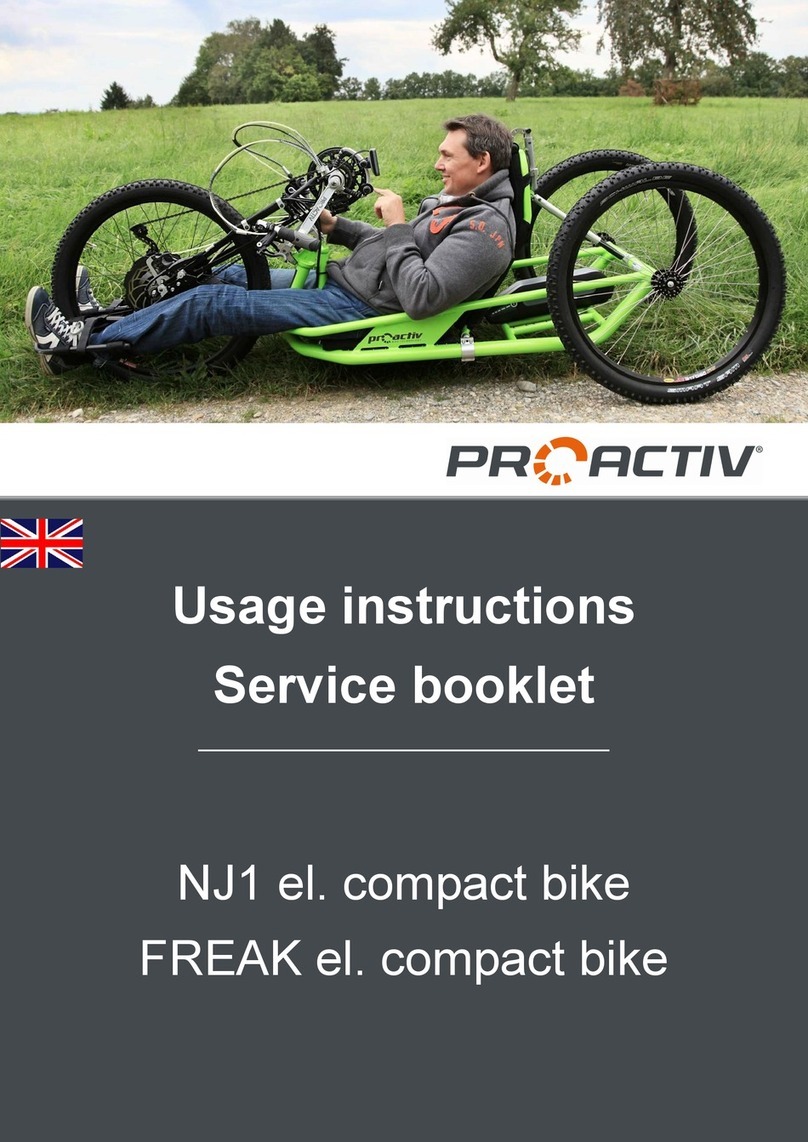
ProActiv
ProActiv NJ1 el. Parts list manual

ProActiv
ProActiv SPIKE Adaptive bike Troubleshooting guide

ProActiv
ProActiv NJ1 el. Troubleshooting guide
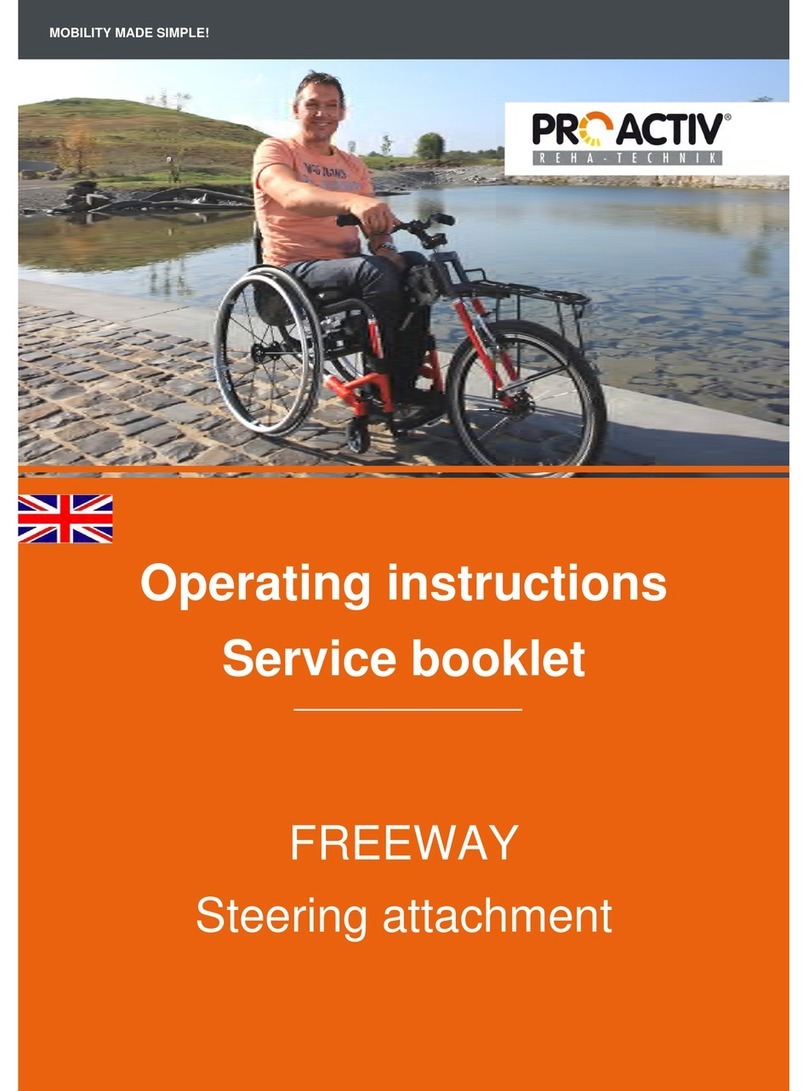
ProActiv
ProActiv FREEWAY Troubleshooting guide

ProActiv
ProActiv NJ1 User manual
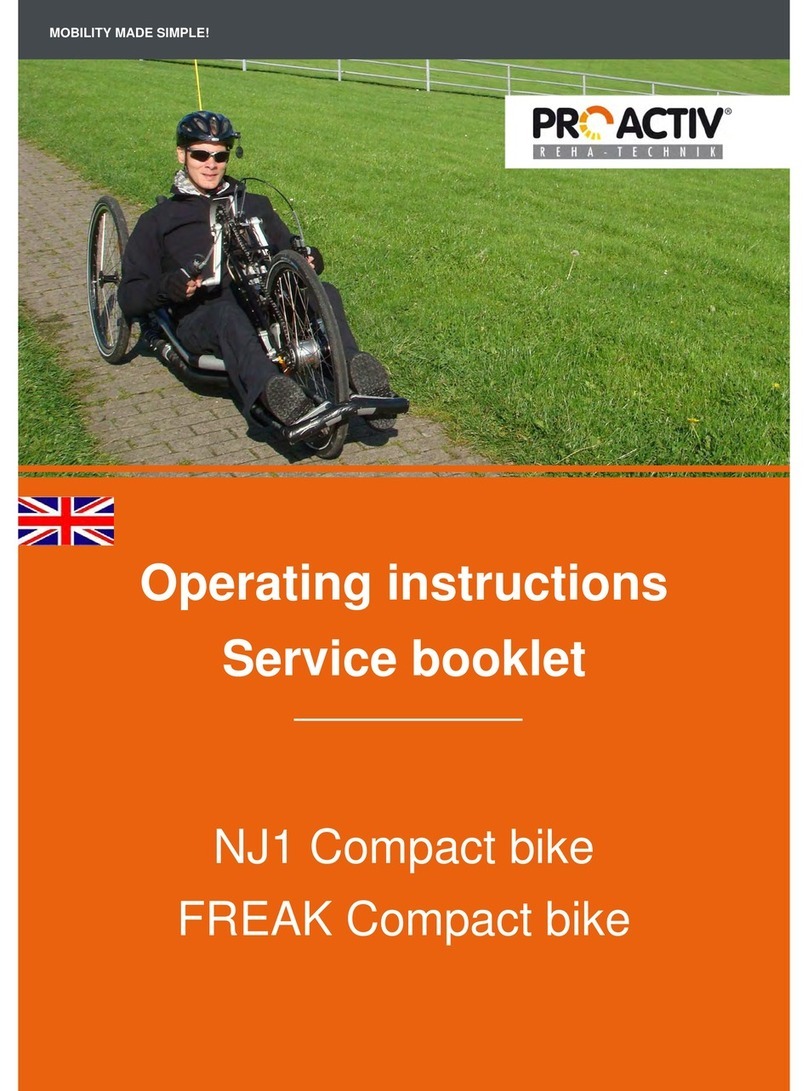
ProActiv
ProActiv FREAK User manual

ProActiv
ProActiv RAPTOR 4all Troubleshooting guide
